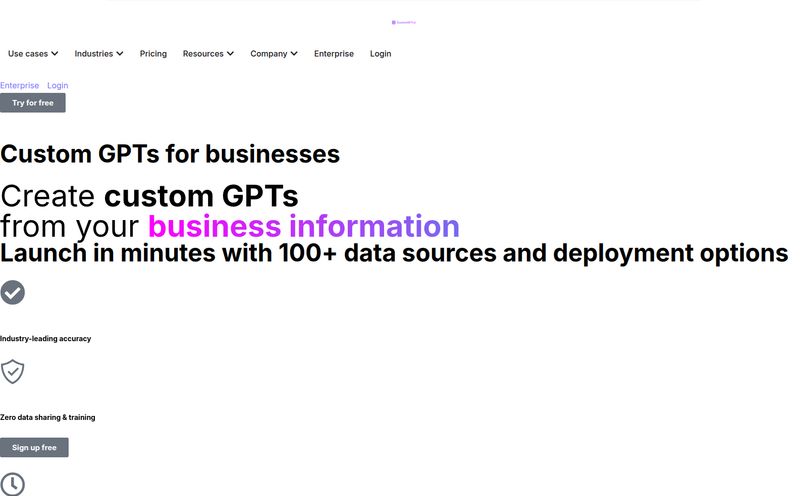We’ve all been there. That spark of a new SaaS idea hits you. It's brilliant, it's innovative, it’s… going to take forever to set up. You sit down, crack your knuckles, and begin the age-old ritual: `npx create-next-app@latest`. Then comes the authentication setup. Then wiring up a database with an ORM. Then installing a UI library, configuring payment providers, setting up email services. By the time you’re ready to write the actual code for your brilliant idea, a week has passed and your motivation is flagging.
It's a frustrating cycle. It's the technical equivalent of having to build your own car factory just to test drive a new engine design. I've personally lost count of the number of `auth.js` files I've written in my career. And frankly, I'm tired of it.
That's why when I stumbled upon NextReady, my curiosity was definitely piqued. It's a Next.js boilerplate, but calling it just that feels like an understatement. It’s more like a complete project launchpad, designed by developers who have clearly felt this same pain. It promises to let you skip the grunt work and get straight to the fun part—building your actual product.
So, What Exactly Is NextReady?
At its heart, NextReady is a pre-configured, production-ready codebase for building modern web applications. It’s built on a stack that would make any modern web developer nod in appreciation: Next.js with the App Router, TypeScript for that sweet, sweet type safety, Prisma as the ORM, and shadcn/ui for components. It's not just a collection of technologies; it's a thoughtfully integrated system designed to work together right out of the box.
Think of it like buying a professional chef's mise en place. All the ingredients are chopped, the sauces are prepped, and the oven is preheated. You just get to do the creative, high-impact work of cooking the meal. It's an opinionated setup, for sure, but its opinions are, in my experience, very good ones.

Visit NextReady
The Features That Genuinely Save Time
A feature list is one thing, but real-world impact is another. Let’s break down what NextReady offers, not just as bullet points, but as solutions to real problems we face as developers and entrepreneurs.
The Core Stack: A Developer's Dream Team
The foundation of any project is its tech stack, and NextReady has chosen its team well. Using the Next.js App Router means you’re on the cutting edge of the framework, ready for server components and modern data fetching patterns. The inclusion of TypeScript is non-negotiable for any serious project these days, saving you from a world of runtime errors. And they use Bun as the package installer! For anyone who has waited for `npm install` to finish on a large project, the speed of Bun is a godsend. It's a small detail that signals a deep understanding of developer experience.
And then there's Prisma. I've always had a soft spot for Prisma's developer-friendly API. Having the models and client already initialized for a PostgreSQL database means you can define your schema and start querying data in minutes, not hours.
Getting Paid: Built-in Payment and User Management
This is where things get really interesting for anyone building a SaaS. Building authentication and billing logic is a universal requirement, and it's universally tedious. NextReady comes with complete auth components and APIs. We're talking register, login, password reset, Google OAuth, and even magic links. That alone saves days of work.
But it doesn’t stop there. It has a full-fledged Admin Panel with user management and role-based access control. You can see your users, manage their data, and assign roles without writing a single line of admin-specific code. When combined with the pre-built integration for Lemon Squeezy (and Xendit), you have a nearly complete billing and subscription management system from day one. Honestly, this is probably the biggest time-saver in the whole package.
More Than a Shell: SEO, AI, and Storage
A lot of boilerplates give you a structure and call it a day. NextReady goes further. As an SEO guy, I was thrilled to see a blog-ready setup with markdown support and automatic metadata generation. Content marketing is the lifeblood of many SaaS startups, and having a performant, SEO-friendly blog baked in from the start is a massive advantage.
It also includes an AI wrapper for services like OpenAI, Gemini, and Claude. In 2024, AI features are becoming table stakes, and being able to integrate them easily on both the frontend and backend is a huge plus. It shows the project is actively maintained and keeping up with current trends. Finally, the built-in AWS S3 integration for cloud storage handles file uploads and downloads, another one of those deceptively complex tasks that this boilerplate just... handles.
Is The Developer Experience Any Good?
A powerful tool is useless if it's a nightmare to work with. The NextReady site has this tagline, "From Developer to Developer," and it feels authentic. The code snippets they show are clean, modern, and readable. It looks like a codebase I would actually enjoy working in.
The true test of a boilerplate isn’t just the initial setup, but how you feel when you're 20 commits deep and need to change something. A good developer experience (DX) means the code is logically structured, components are reusable, and you can trace data flow without wanting to tear your hair out. From what I can see, NextReady gets this right. The focus on TypeScript and a well-organized file structure is a massive step in teh right direction.
Let's Talk Money: The NextReady Pricing
Alright, the all-important question: what does it cost? NextReady has a straightforward pricing model that I actually really appreciate.
| Plan | Price | Details |
|---|---|---|
| Lifetime License | $98 | One-time payment for access to all features and future updates. |
So, is $98 a lot? Let's do some quick, back-of-the-napkin math. How much is your time worth? If you're a freelance developer charging, say, $75/hour, this boilerplate pays for itself in about 80 minutes of saved work. Given that setting up auth and payments properly can easily take 10-20 hours, the return on investment is, frankly, absurdly high. You're trading a one-time fee to save literally thousands of dollars in development time.
The Not-So-Perfect Parts
No tool is perfect for everyone, and it's important to be honest about that. The biggest "con" of NextReady is also its strength: it's opinionated. If you're a die-hard Vue fan, or you prefer Stripe to Lemon Squeezy, or you want to use a different ORM, you'll either have to do some significant refactoring or this simply isn't the tool for you.
It also assumes a certain level of familiarity with its tech stack. If you've never used Next.js or TypeScript, there will be a learning curve. This isn't a tool for an absolute beginner to web development, it's an accelerator for those who already know the landscape and want to move faster.
Who Should Buy NextReady? (And Who Should Skip It?)
After looking it over, the ideal customer profile is crystal clear to me.
This is a perfect fit for:
- Indie Hackers & Solopreneurs: Your time is your most valuable asset. NextReady lets you focus on building features and finding customers, not reinventing the wheel.
- SaaS Founders: You need to get an MVP to market as quickly as possible to validate your idea. This is your fast track.
- Freelance Developers: Spinning up new projects for clients? This can standardize your stack and drastically cut down on initial setup time for every single project.
You might want to skip it if:
- You're an absolute beginner still learning HTML and CSS.
- Your company has a rigid, pre-defined tech stack that doesn't align with Next.js, Prisma, etc.
- You're just building a simple, static landing page (though it can do that, it might be overkill).
My Final Verdict
I’m genuinely impressed with NextReady. In a world full of half-baked templates, it stands out as a comprehensive and thoughtfully constructed system. It's not just code; it's a productivity tool. It solves the most common, time-consuming problems of web app development so you can focus on what makes your project unique.
The one-time price for a lifetime license makes the value proposition incredibly strong. It’s less of a boilerplate and more of a business investment. A launchpad for your next big idea. Now, what are you going to build?
Frequently Asked Questions
What is NextReady in simple terms?
NextReady is a pre-built code template (a boilerplate) for the Next.js framework. It comes with essential features like user authentication, payments, an admin panel, and an SEO-ready blog already set up, so you can launch your web application or SaaS product much faster.
Is NextReady good for beginners?
While it's well-documented, NextReady is best suited for developers who already have some experience with JavaScript/TypeScript and frameworks like Next.js. An absolute beginner might find the stack a bit overwhelming. It's more of an accelerator for experienced devs than a learning tool.
Can I use my NextReady license for multiple projects?
The lifetime license typically allows you to use the boilerplate for multiple projects you own. It's always best to check the exact terms on their website, but this is standard practice for such tools and a key part of its value for freelancers and serial entrepreneurs.
Is the $98 lifetime license worth the price?
In my opinion, absolutely. Considering a developer's hourly rate, the license pays for itself within the first few hours of avoided setup work. If it saves you even one or two days of development time on a single project, the ROI is massive.
What payment gateways are supported?
NextReady comes with built-in integrations for Lemon Squeezy and Xendit, which are popular choices for SaaS and digital products, especially among indie developers.
How does the AI integration work?
It provides a ready-to-use AI wrapper that makes it easy to connect your application to various large language models (LLMs) like OpenAI's GPT series, Google's Gemini, and Anthropic's Claude. This simplifies the process of adding AI-powered features to your app.



